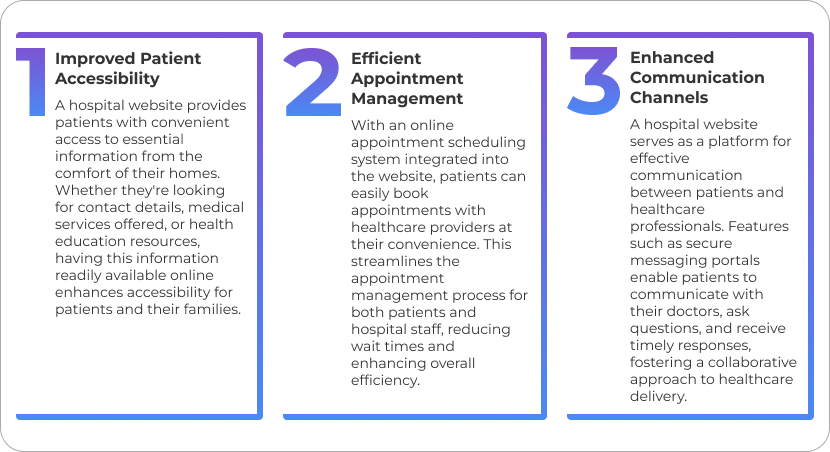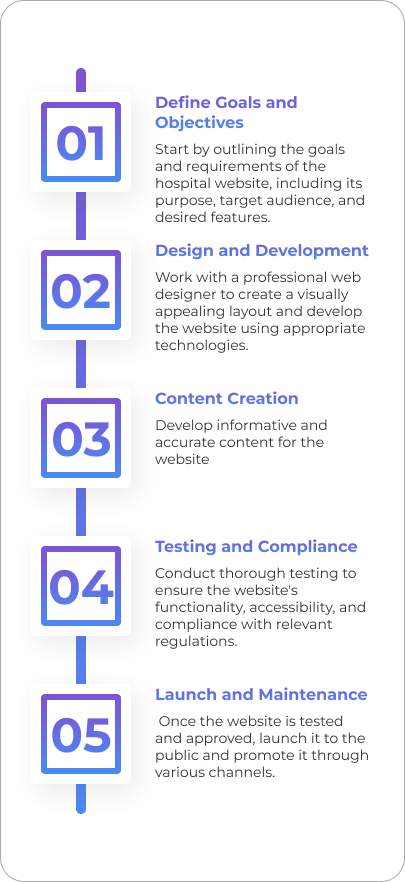Creating a Comprehensive Hospital Website
- 08.05.2024
- 15 views
- 10 min
Creating an effective hospital website
Today, more and more hospitals provide online services. A well-designed and informative website serves as a gateway for patients to access critical information, connect with healthcare professionals, and ultimately receive the care they need. However, creating a website for a hospital requires careful planning and attention to detail to ensure it effectively serves its purpose.
Creating an effective hospital website requires careful consideration of various factors. The website should be easy to navigate for individuals of all ages and abilities, ensuring that anyone seeking information can find it effortlessly. Additionally, in an era where smartphones and tablets dominate, ensuring compatibility across different devices is crucial.
Advantages of Creating a Hospital Website
As the healthcare landscape continues to evolve, hospital websites emerge as indispensable tools in enhancing patient care and engagement. Beyond mere digital placeholders, these online platforms offer a myriad of benefits that revolutionize healthcare delivery and accessibility. Let's delve into the advantages of creating a hospital website and how they contribute to elevating patient experiences and operational efficiency:

Health Information Resources: Providing reliable health information and educational resources on the website empowers patients to take control of their health and make informed decisions. From articles on common medical conditions to wellness tips and preventive care guidelines, these resources support patient education and engagement.
Requirements for a Medical Website
Creating a website for a hospital or medical institution comes with specific requirements to ensure compliance with healthcare standards and regulations. These requirements encompass various aspects, including privacy, accessibility, and accuracy of medical information.
- HIPAA Compliance: The Health Insurance Portability and Accountability Act (HIPAA) sets strict guidelines for protecting patients' privacy and confidential health information. A medical website must adhere to HIPAA regulations by implementing secure data storage, transmission, and access protocols to safeguard patient data from unauthorized disclosure.
- Accessibility Standards: Ensuring accessibility is crucial to accommodate individuals with disabilities and facilitate equitable access to healthcare information and services. Medical websites should adhere to accessibility standards such as the Web Content Accessibility Guidelines (WCAG) to provide a seamless browsing experience for users with visual, auditory, motor, or cognitive impairments.
- Medical Accuracy and Transparency: Medical websites serve as trusted sources of health information for patients and the public. Therefore, it is imperative to ensure the accuracy, reliability, and transparency of medical content presented on the website. Information regarding medical services, treatments, and conditions should be sourced from reputable medical authorities and reviewed regularly to reflect the latest evidence-based practices.
- Clear Communication Channels: Effective communication channels are essential for facilitating interaction between patients, healthcare providers, and administrative staff. A medical website should feature intuitive contact forms, appointment scheduling tools, and secure messaging portals to enable seamless communication and coordination of care.
Stages of creating a website for a hospital
Building a website for a hospital involves a structured process to ensure its effectiveness, functionality, and compliance with industry standards. Here are the key steps to consider when creating a hospital website.
 Define Goals and Objectives:
Define Goals and Objectives:
Start by outlining the goals and requirements of the hospital website, including its purpose, target audience, and desired features. Collaborate with stakeholders to gather input and ensure alignment with organizational objectives. This initial planning stage lays the foundation for a successful website development process.
Design and Development:
Work with a professional web designer to create a visually appealing layout and develop the website using appropriate technologies and content management systems. Focus on user experience and interface design to ensure intuitive navigation and engagement. Regular communication between designers and developers streamlines the development process and ensures timely delivery.
Content Creation:
Develop informative and accurate content for the website, including service descriptions, physician profiles, and patient education resources. Engage subject matter experts to provide valuable insights and ensure content authenticity. Regularly update content to reflect the latest medical advancements and maintain relevance.
Testing and Compliance:
Conduct thorough testing to ensure the website's functionality, accessibility, and compliance with relevant regulations such as HIPAA and ADA. Test across different devices and browsers to ensure compatibility and responsiveness. Compliance with security standards and data protection measures is paramount to safeguard patient information.
Launch and Maintenance:
Once the website is tested and approved, launch it to the public and promote it through various channels. Monitor website performance and user feedback to identify areas for improvement. Regularly update content and security measures to keep the website relevant and secure.
Conclusion
Ultimately, a well-designed and maintained hospital website can improve accessibility to healthcare services, facilitate communication between patients and healthcare providers, and strengthen the hospital's relationship with the community. By investing in their online presence, hospitals can enhance patient experiences and support their mission of providing high-quality healthcare services.









